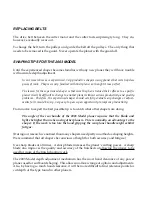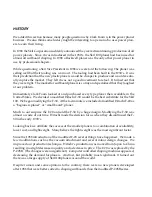
For length geometry there are three basic scenarios. All three scenarios are modified to some
degree as the planer is turned sideways or compound curves are encountered. They are:
1.
The first is a perfectly flat surface. Both base plates have 100% surface contact. The
longer the planer the straighter the cut will be.
2.
Second is a concave surface. This is like the deck nose area on most boards. Here the
front of the front base plate and the rear of the rear base plate are all that is touching
the blank. A shorter planer works best. While planing a concave surface the shorter
planer’s cutting depth adjustment is also a lot more accurate.
3.
Third is a convex surface. This is probably encountered a lot as the planer is turned
sideways with a slightly round bottom or deck. It is also encountered a lot on the
bottom of a board. When planing on a convex surface you can rock the planer back
and forth from front to rear altering the base plate surface that is touching the blank.
In the most natural and accurate cutting position the pressure would be on the rear of
the front base plate and the front of the rear base plate. In this position the ends of the
planer are not touching anything. Therefore the overall length of the planer is irrel-
evant. A long planer and a short planer work exactly the same.
The above holds true only when the base plates and blades are perfectly indexed.
SKIL 100 PLANER COMPARISON TO THE 2003 MODEL
When switching from one planer to another it is helpful to know the differences between the
planers for the purposes of adjusting to the different planer and making a decision as to
which planer to use. When comparing the 2003 Model to the Skil 100 below are some of the
more significant differences:
-
The Model 2003 is a little over one half the weight of the Skil 100. This appears to be the
main incentive for considering the 2003 Model.
-
The front base plate of the 2003 Model is about 3/8" narrower and 5/8" shorter than the
Skil 100. (By custom order we can make the front base plate the same width as the Skil
100 and slightly longer.)
-
The rear base plate on both planers is identical in width.
-
Most Skil 100 planers have the rear base plates modified to 8" or less in length. The
Model 2003 has a 6 1/2" rear base plate. (It is possible to make an extended base plate
for the Model 2003 from 1/4" aluminum plate and shims. We tried this at Clark Foam
and saw no advantage.)
Summary of Contents for 2003 Model Foam Planer
Page 1: ...CLARK FOAM PLANER 2003 MODEL SAFETY AND OPERATING INSTRUCTIONS Version 1 2003 ...
Page 4: ......
Page 13: ......





































